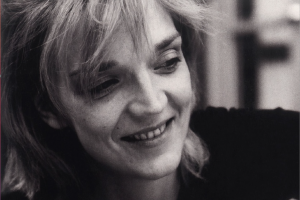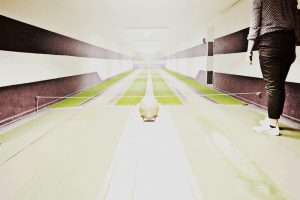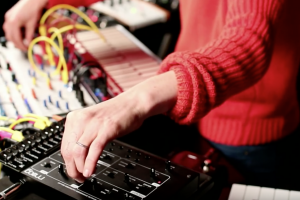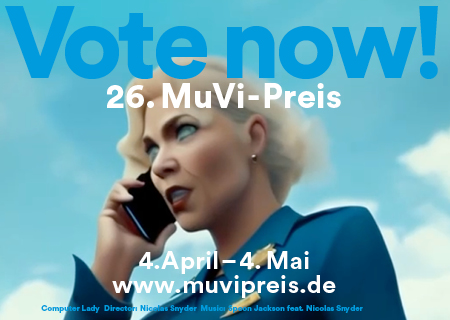Ka Baird: „What now has become my performance persona originally came from this closed place”

Ka Baird, performing at Papiripar Festival 2019, Photo by Claudia Höhne
It is a rainy Saturday evening in Hamburg. But in Westwerk, a small club on the Fleetinsel of the town, the mood is hyped. Papiripar is taking place, the festival for pop, art and rotation. The woman on stage combines all of these. She plays several instruments, wears an all white costume and is rotating her arms, holding a microphone in each hand. When the microphones pass her mouth, the breaths, spits and melodies she creates pan quickly from one side of the stereo system to the other.
The woman responsible for this stunning performance is Ka Baird, a music performer from Brooklyn who is releasing her new album “Respires” these days on New York based label RVNG Intl..
What really amazed me last night was this effect stimulated by the two microphones that you used. When did you come up with this idea?
It was in May last year, while preparing for a performance for my Jerome Foundation residency at Roulette in Brooklyn, NY. I decided to do two 4-channel-pieces, a vocal piece as well as a piano piece. During the preparations for the vocal piece I started doing this two-microphone technique, mostly a very hands-on way to get an extreme panning effect but also a way to combine different settings crisscrossing with each other. I was also attracted to the physicality of it. I found this more interesting than using some kind of plugin. A lot of ideas that ended up on my new album “Respires” were birthed while preparing for this show at Roulette.
The effect looks really cool on the stage.
For sure. I’ve been trying to perfect my technique. Even last night I hit my mouth with one of them. At one show I knocked out a tiny bit of my front tooth. That’s the uncool part. I’m not purposefully going for self-destruction.
The evening before Céline Gillian did a performance music piece about stage fright. You are quite the opposite in some way. You even said, that you consider yourself more a performer than a musician.
When I first started making music, performing would make me feel incredibly nervous too. I felt kind of locked up. In the beginning with my group Spires that in the Sunset Rise I sat in a chair, trying so hard to get my part right. What now has become my performance persona originally came from this closed place. In order to deal with nerves I would often jump around a lot in order to deal with my performance anxiety. My moves on stage embodied my fear. When I started to explore pure improvisation the floodgates opened up even more. Performance became a catharsis, not something to be dreaded.
What else do you do to keep the tension in your live set?
When I moved to New York in late 2014 and started performing solo, there were a couple of things that I wanted to do:
One – I wanted to create a seamless live set, an uninterrupted experience with no stopping and starting, one with the intention of creating for myself and others – a transformative, potentially transcendent experience.
The other thing was to incorporate more electronics and live beats.
And beyond those things I always keep the tension alive in my performances through increasingly physical and embodied performance . There is an extreme urgency in my body when I perform.
What role does the audience play in your performance?
I want them to get lost in the sound like I do. And although, I seem to be very free and brave on stage, I still find it an incredibly awkward, unnatural situation to negotiate:
What am I to you?
What are you to me?
Of course the ideal is to not think about this on stage. I can easily go through a performance without looking at the audience. I’m trying to get better, by at least looking out a few times during the set! I also like to think my solo sets have the potential to be a more cathartic experience for the audience because they see me give so much. With Spires That In The Sunset Rise it always seemed more overly meticulous and also more raw and unrefined at the same time.
But you recorded so many beautiful songs with Spires That In The Sunset Rise, like for example “Child of the Snow”.
Actually you are right. Spires started in 2001 and is still going, we have been doing this for nearly twenty years and have gone through so many phases. The first albums were a lot weirder. The newer albums are different and as you said even quite ethereal and beautiful. Maybe I just keep in mind the reactions we got from our first few records and transfer it to the newer albums. But Spires is not so easily defined. Somehow it could be that some of my stuff now is even weirder.
Talking about Spires That In The Sunset Rise. Your new record is called “Respires”, quite a meaningful title. You use a lot of voice on the album, and for this you have to „respire“ – take breath. And it namedrops your group.
Ha, yes! As I was thinking of a name for the record I wanted to reference breath. The latin root word for spirit, „spiritus“, means breath, also combining spirit with breath. And this went as well into the verb respire. So this is the meaning that I mostly wanted to express. The reference to Spires was an afterthought but a super fun one.
Besides the voice, you play a lot with the flute which is a breathing instrument as well.
The flute is definitely an extension of my voice and breath, another way of channeling it. The flute is perhaps the breathiest, air-iest of all the instruments. So along with playing the flute in the traditional way I also began using it as a vessel to sing and breath through. I was inspired by this record that was reissued a few years back through Ideologic Organ called “Sacred Flute Music from New Guinea: Madang/Windim Mabu”. The New Guinea musicians at times sang through these flutes during sacred initiation rites. The breath of the flute was considered sacred and a way to communicate with the gods. Unfortunately it was male dominated, women weren’t allowed to play the sacred flutes.
Around here the flute is mainly played by women.
It’s crazy how gendered instruments are. The flute isn’t considered a very cool instrument – haha. Saxophone, cello – now those are sexy, cool instruments. The flute – maybe not so much. In high school I actually wanted to play the saxophone but was convinced by some boy that it was a boy’s instrument. So I chose the flute instead, which is maybe the most cliché female instrument. I played the flute through grade school and part of high school and put it aside for more than ten years. My brother later leant my flute to someone else and when I wanted it back it was missing. However, miraculously I got it back and playing it still.

Ka Baird, performing at Papiripar Festival 2019, Photo by Claudia Höhne
This is still your first flute?
It’s still my same fucking first flute! Whenever I get it serviced though they are always like this is a pretty decent student flute! And it is totally sufficient for me, and probably a very good thing that it’s not expensive due to my crazy antics on stage. And it’s the best instrument ever to travel with. You just throw it in your backpack before you leave the venue or the hotel.
Time to redefine the flute.
Totally. When I went more into improvisation, I rediscovered the flute. The flute can be an incredibly rhythmic, funky instrument. I was really inspired by early Kraftwerk where Florian Schneider is doing those crazy breathy rhythmic punctuations on the flute. Most people are influenced by later Kraftwerk but for me those early records are incredible. In some weird way I should thank that boy in grade school who told me to not play the saxophone.
A detail I noticed: on “Sapropelic Pycnic” as well as on “Respires” the longest track is about 11 minutes long and on third position on the record. What about that?
Well, records can be annoying in the sense of the time restrictions, 15-20 minutes on each side. You just try to find the right mix between logistics and flow. In the live set I play this song you mentioned, „Teaching Lodge of The Arrows“ more towards the end. I play this very energetic, loud song right before which flows directly into “Teaching Lodge” where all effects are dropped and it is just solo raw unprocessed flute for a moment. It always captures and embarrasses that one person talking loudly in the back of the room.
What does the title “Teaching Lodge of the Arrows” mean?
Actually it comes from an alternative tarot deck. Titles/lyrics are for me a combination of well thought out processes and pure randomness. I totally subscribe to automatic writing techniques. There are not many words on the record, just a few well-placed mantras here and there. Artistically I feel lost with words. They are so powerful and dictating. It turns out „Teaching Lodge of the Arrows“ was a good title for this track because there is this tangle between the flute and synthesizer lines that searches for its aim and then finds its direction with the long drone at the end. So this is maybe just a long answer to say that I decided to name the song after the first card I drew from the tarot deck.
You are oscillating between control and randomness.
Absolutely. I construct a solid roadmap, but there are many moments that are free where I allow myself to explore and let go.

Ka Baird, performing at Papiripar Festival 2019, Photo by Claudia Höhne
On the record you have many tribalistic electronic drum sounds.
Ultimately I try to create sounds that I am drawn to and that I can get lost in. There is a momentum in there where they can become ritualistic. It wasn’t something that I planned to do necessarily. But as my sets became more cathartic exercises, they began to be read that way. In the process of composing I am analytical and judgmental, but the idea is to find a container where I can become one with the music.
Maybe there is some universal archetype that comes out at certain moments with tribalistic drum sounds on tracks like „Symanimagenic“ or „The Orion Arm“. Although at the same time I can admit that I have been super inspired by world music, early Smithsonian Folkways recordings from places far far away. Which is a something I am grappling with and talking to a lot with people about the potential problematic nature of that, because in some way it’s always romanticising „the other“. Is it valid to be inspired and take inspiration from music in which you have no understanding or very little understanding of the context in which it comes from?
On stage your music does not seem like a reenactment of world music to me. I had to think more of alien tribes from outer space. As well with the way you use your voice.
Someone else has described it in a similar way. He told me the music reminded him of some secret alien cult music. And he didn’t know if he was welcome or if he even understood what was going on.
When you later get to your plane, what music will you listen to?
A friend of mine told me recently she always gets migraines on planes and the music of French minimalist composer Éliane Radigue really helps her with that. On my last plane ride I dialed up her sounds and felt so nested and enraptured. Her electronic works are so beautiful, so arresting. She was an inspiration for sure for the drone sound at the end of „Teaching Lodge of the Arrows“. My live set is so physical and spastic that it is really powerful when I just stop and do nothing. Maybe just breathe. Calmly.
“Respires” is coming out via RVGN INTL.














